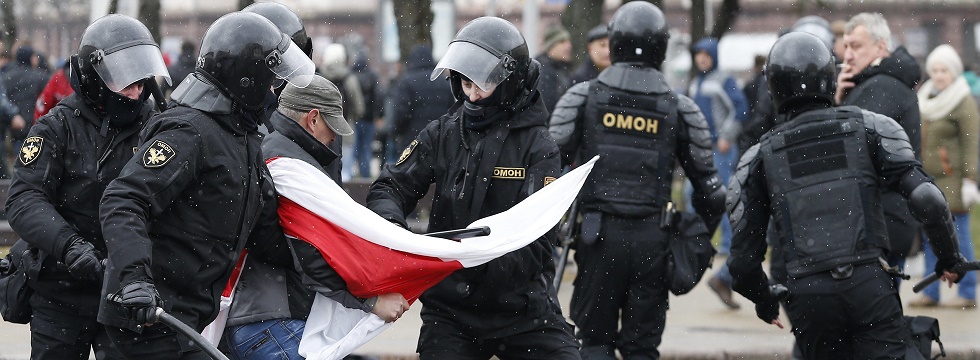Continuing tensions with Russia, Lukashenka does it best in measuring an optimal level of repressions, high enough to discourage Belarusians from continuing protests and low enough for the EU to continue a gradual rapprochement with Minsk.
Andrei Yeliseyeu, for the New Eastern Europe

Over the past month and a half, thousands of Belarusians took to the streets protesting against dire economic conditions and demanding resignation of the country’s long-term ruler, Alexander Lukashenka. The Belarusian authorities have employed a set of measures to crack down on protests without jeopardising relations with the EU.
Social parasitism tax
The large-scale protests in Belarus, which have been taking place over the past six weeks, were triggered by the decree “On prevention of social parasitism”. The new law imposed a levy of about 180 euro on the able-bodied citizens employed for less than 183 days in a given year. This year is projected to be a third consecutive year of economic downturn in Belarus. Living standards have fallen sharply and mass staff cuts have taken place since 2014. Needless to say, the decree turned out to be very untimely.
Although the decree was adopted back in 2015, crowds started pouring into the streets on the eve of February 20th 2017, which was set as a final date to make payments. Although late payments carry penalties and dodgers may face compulsory labour and up to 25 days in jail, most of the alleged social parasites boycotted the tax. By the deadline, only around 50,000 Belarusians paid the levy out of approximately 470,000 of persons asked to do so by tax authorities.
It does not come as a surprise that the new tax was met with a widespread resentment among Belarusians. In addition to legal problems with the decree, it unfairly punishes many thousands of people unable to find a job.
As long as unemployment benefits are miniscule in Belarus and the whole system of unemployment support is largely ineffective, most Belarusians seeking employment do not see a reason to register at state job centers. Therefore, many unemployed people, instead of getting a meaningful state support, found themselves indebted by the new law. The decree also targets tens of thousands of Belarusians who were not looking for a job and living off their own or their family members’ savings, be it housewives or persons recovering from an illness.
The March of Disgruntled Belarusians on February 17th in Minsk gave rise to a series of protests across the country. In the following weeks, the streets of all other five regional Belarusian cities and a number of smaller towns saw thousands of people demanding revocation of the decree, voicing economic and even political demands. Rallies in the country regions gathered many people who had never taken part in anti-governmental protests before. Reacting to such developments, the Belarusian authorities quickly came up with a set of measures aimed at cracking down on dissent.
More sticks than carrots
On March 9th Lukashenka blamed local state officials for excesses in executing the decree and ordered to put on hold levy payments for a year. However, this concession and unwillingness to revoke the decree was taken negatively by the public. Reluctant to back down, Lukashenka quickly turned to a variety of repressive measures against protestors and independent media, trying to discredit and intimidate political opponents.
First, the authorities began an intense smear campaign against protestors.“There would be no problem to break heads of two thousand scumbags gathered at a square. But this is bad. You have to anticipate their actions”, Lukashenka instructed high KGB officials.
Chairman of the Belarusian TV and Radio Company Gennady Davydkopubliclynamed those calling for protests “cockroaches”. The expression “fifth column” has become yet another popular term in the Lukashenka’s verbal arsenal to denominate political opponents.
Two propaganda movies aired in prime time on a state TV channel presented protests as an attempt by some opposition structures, allegedly financed from abroad, to make Belarus “going down the Ukrainian path”. Eerie music background and bloody documentary footages from Donbas accompanied the movies, discouraging viewers to join the protests. However, in fact, in many cases protest rallies became possible thanks to self-organisation of people in social networks, and not any coordinated activities of the opposition.
To support the argument, a story was made up about a jeep loaded with weapons and ammunition which allegedly arrived in Belarus through the border with Ukraine.
A bad-quality video footage was released showing a car hitting a barrier, the backs of two allegedly apprehended car passengers and weapons found in the car. However, the Ukrainians were quick to denounce the claim that the car had come from Ukraine. No further details about the accident or the identity of alleged violators have been disclosed by the state media or security bodies, which may indicate that the story was fictitious.
Second, a widespread intimidation campaign targeting possible future protestors intensified before the largest protest rally planned for March 25th. The authorities deployed excessive forces ready to crack down on peaceful protests, including SWAT policemen patrolling Minsk’s central square with rifles. After an authorised rally on March 15th, more than 20 peaceful protestors were brutally detained in public transport by plain-clothed policemen. The video of detentions quickly spread in social networks and gathered hundreds of thousands of views in Facebook alone.
A few days before the planned late-March rally in Minsk, a criminal investigation into alleged preparation of mass riots was opened by the KGB.
Around 30 people were arrested in connection with this case, four of whom are members of law enforcement agencies. This was to show that the authorities have uncovered a conspiratorial network. However, the problem with the official version is that the White Legion, a nationalistic organisation which is said to be behind the network, ceased to exist about 15 years ago. Relatives of some of the detainees say the weapons allegedly found during apartment and car searches were planted by state security officials.
Third, the authorities used repression against independent media and journalists, as well as arrested a dozen of people who reposted calls to join the protests in social media. More than a hundred of journalists covering the rallies were detained, some of whom were arrested for up to 15 days based on accusations of hooliganism or participation in unauthorised public event. Repressions often targeted journalists working for online media, which reflects Lukashenka’s observation that information wars in the internet have been “the main battlefield”. This remark also has also strengthened the belief in Belarusian “troll factories”.
The Ministry of Information accused the largest Belarus’ media portal TUT.by and the online newspaper “Nasha Niva” of spreading information “capable of damaging Belarus’ national interests”. According to Belarus’ legislation, in case of a second warning to a media outlet in a given year, access to it may be restricted for an indefinite period of time. Concerned with the popularity of online streaming of the protests, the Belarusian authorities have recently raided the offices of the Poland-based Belsat TV, confiscating the equipment and documents.
Getting the right dose of repressions
As a result of these measures, just a few thousands of people were brave enough to take to the streets of Minsk on March 25th. This date marked the 99th anniversary of the proclamation of independence of the Belarusian Popular Republic in 1918. The protestors were confronted by an even larger number of heavily-equipped policemen. As a result, up to 700 people were detained, in addition to more than 200 who had been arrested in the previous weeks. However, only about 100 people faced administrative arrests, while the rest were released later that day. This was different from the post-2010 presidential election events, when almost all detained protestors served time in prison.
The change in tactics does not indicate Lukashenka’s mercy towards the protestors, but his aspiration to continue the dialogue with the West.
After Crimea takeover by Russia in 2014, Minsk, mindful of its excessive political and economic dependence on Russia, began to develop closer ties with the EU. However, a large number of arrests and new political prisoners may disrupt Belarus’ normalisation of relations with the West. Severe repressions could also put into question the Pope’s visit to Belarus, which the country is expecting in 2017.
In an attempt to put pressure on the Kremlin to be more generous and accommodating with Belarus, last December Lukashenka ignored the Russia-backed Collective Security Treaty Organization and Eurasian Economic Union summits that took place in St. Petersburg. This demonstrative move did not, however, bear the fruits. Expecting to meet Putin in February, Lukashenka spent several days in Sochi, but by the Russian president ignored his presence. It remains to be seen what the result of today’s meeting between Putin and Lukashenko will be.
The Kremlin keeps asking Belarus to pay the debt on its gas bill, which now exceeds 700 million dollars. In response to the lack of progress, Russia started to cut duty-free oil supplies to Belarus in mid-2016. Exports of refined oil products to the EU and Ukraine have crucial significance for the Belarusian economy, and the Kremlin’s decision has led to big losses. Thereby, amid continuing tensions with Russia, Lukashenka does it best in measuring an optimal level of repressions, high enough to discourage Belarusians from continuing protests and low enough for the EU to continue a gradual rapprochement with Minsk.

